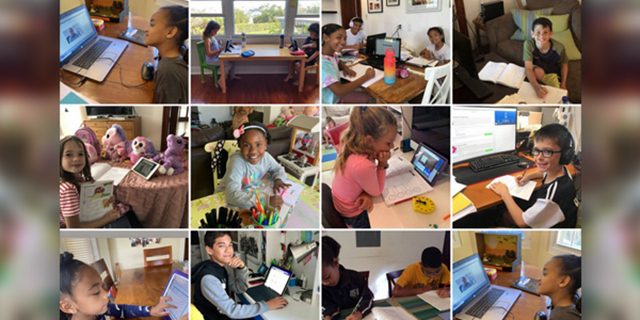[Written by Warwick Academy student An Mei Daniels]
My school, Warwick Academy, is now several days into its programme of remote learning, which commenced on Friday 20th March in response to school closures due to the Covid-19 virus.
In the days leading up to the school closure, teachers immediately started training so that the remote learning programme could be implemented as quickly as possible. Despite the air of uncertainty, school was able to continue like usual during this transition period, allowing students and teachers alike to prepare and adjust to the idea. Within two days of the school being shut down, it was back up and running, albeit online and from a distance.
The remote learning programme has been an interesting time for us all. Despite all of the doubt surrounding this time period, the rapid implementation of a new learning tool has kept a semblance of normalcy and routine. Whilst the system isn’t perfect, the school’s determination to provide the best quality teaching and dedication towards continuous improvement is a testament to the resilience of the Warwick Academy spirit.
Upon introducing the new system, Principal Dave Horan said, “Today is the start of our new dawn and I am sending out this message to support the commencement of our remote learning environment. It is remarkable to think that three days ago we were teaching in what one may call a ‘normal’ environment and now find ourselves miles apart and still teaching but in a very different ‘remote’ environment. It has taken a herculean effort on the part of all our staff to get here and I must thank them for their relentless efforts. This is just the start of a journey which will require a lot of listening, adjustment, tweaking and innovation.”
The new Secondary School learning environment relies on the Microsoft Teams, a software application that allows students and teachers to remain in contact. This is done via virtual classrooms where peers and teachers can chat, call each other, assign tasks, and provide feedback. Warwick Academy, in addition to sustaining its educational environment, is also continuing to offer its pastoral care and extra curriculars via the Teams app, with online guidance counselling, a virtual chess club, and frequent updates from Heads of Year with reminders to exercise and self-care. In no time, we have all found our routine, setting up an environment at home where we can study, with teachers and students alike discovering what works best for them.
The younger Secondary year groups are in virtual classes, allowing them to continue learning and discovering from home, keeping their education on track. Jack Butterworth, Y8, said that “remote learning is very different and requires you to be independent and organised.” Rachael Betschart, Y10, added “it’s sometimes more stressful, but most of the time I enjoy it.” Olivia Buchanan, Y9, remarked that “the online learning is quite easy and convenient. I am enjoying using it as I can continue my classes from home.”
The older year groups are also continuing to work, not letting the virus disrupt their track towards their futures. Whilst the graduating class is missing some of their traditions, such as the Valedictory Assembly and Prank Day, the school is ensuring that they still find ways to celebrate their final year virtually, and that we are continuing to work towards life beyond secondary school.
Noah Da Silva, Y12, stated that “we are disappointed not to be learning in the engaging educational environment at WA, but the way that remote learning has been approached has made it easy to always keep in touch with the support staff at WA, making sure that we’re never left stranded on our education. It’s not a perfect system, but it’s functional, easy to use, and there are continuous attempts to improve it.”
Daniel Simmons, Y13, added that “it’s been an interesting adjustment, but it really allows you to work at your own pace which is something I find beneficial. I feel that the school has really done a good job of setting up a reliable learning environment in the midst of the confusion, and it’s useful that teachers are available if you need assistance.”
Cameron Pollett, Y12, summarised that “it’s an innovative and flexible solution to Covid-19.”
The teachers, too have found their stride, so that they can continue providing their quality education.
Mr. Eric Totten comments, “The transition to remote rearning has been a whirlwind. I am using several new applications and there have been some inevitable challenges in learning and implementing them in such a short time. The use of these will improve over time and I am excited to use some of these when we return to classroom teaching. With students having many different learning styles, using applications that create screencasts, instructional videos and virtual whiteboards to present content will support what happens in the classroom. I have been very impressed with my classes and how they have adapted to this form of learning. Managing a class is quite different but class video chats and making individual contact with my students has been a very positive experience.”
Ms. Andrea Langerman added, “Remote learning is just as much a learning experience for the teachers as the students. We are all learning a new way of delivering education. These are still early days but I can imagine that, once we are all back in school, this experience will have a positive impact on how we deliver work in the future. Everyone will feel so much more comfortable with the skill set we are building up over the next few weeks or months. This has also made me realise how lucky we are to have the internet. How would we have managed 30 years ago?”
In the Primary School, Seesaw is the online learning platform that has been chosen for student engagement. Teachers can set tasks, upload videos and explanations and receive work in many formats from students. Students “show what they know” using photos, videos, drawings, text, PDFs, and links. The teacher is then able to provide feedback to the student in the form of voice messages, marked, annotated work or just a comment at the bottom of the uploaded work.
Alongside Seesaw there are also a number of online options for primary families including online mathmatics and English programmes [doodlemaths and doodleEnglish] and lots of free online reading books through our virtual online library as well as an online encyclopedia and newspaper. The approach to home learning has to be more flexible in Primary as many of the younger children will need support to complete work and of course parents have many pressures on their time as well, and it is important to recognise this.
So, not all tasks for the day have to be evidenced and uploaded [only the highlighted tasks] and parents and students can choose in which order and when during the day they carry out each task. We have also provided parents with a Seesaw helpline email and a tech team helpline email to support them in the transition, pastoral help sheets and newsletters have been produced and our counselling team are available remotely to help those that may need it at this difficult time. The most important thing has been to provide online and offline activities for the students to create balance.
Watching children do their physical activity challenge for the day, seeing a picture of a wonderful piece of messy art work they have done can be incredibly rewarding for their teachers – but of course not as rewarding as seeing them in the classroom. We are very fortunate to have teachers who are working hard to make this work and parents at home who are diving in with a great attitude as well.
These may be uncertain times for everyone around the island, however Warwick Academy is prepared to forge on, continually upholding its values whilst developing a system that we will be able to use, even after the school closures have ended. The school community has united together in these difficult times, reminding everyone that it is so much more than a place to learn.











